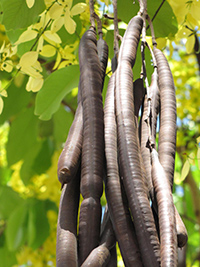Table of Contents
The cassia fistula tree decorates tropical areas of America. It is widespread in the Mexican regions of Tierra Caliente, from Morelos and Guerrero to Tabasco and Chiapas. Its medicinal properties as a laxative are highly appreciated and almost irreplaceable, thus making it part of several worldwide laxative substances.
- Promotes Smooth Purgation
- Supports healthy digestion & detoxification
- Promotes fever reducing response
- Supports healthy skin & immunity
- Lab tested for quality, Non-GMO, vegan & gluten free

Cassia Fistula Tree Scientific Facts
- Other names: Cannafistula tree.
- French: Casse, cassier.
- Spanish: Canafistula.
- Environment: It is native to tropical regions, including India, Southeast Asia, the West Indies, and Central America. It does not grow in Europe.
- Description: Tree of the Leguminosae family, with yellow flowers hanging in clusters. Its fruit is a cylindrical pod, ochre or black, containing black flesh with a sweet flavor besides the seeds.
- Parts of the plant used medicinally: The Flesh of the fruit.

Healing Properties and Indications
The thick and sweet black flesh of the cassia fistula tree fruit contains several sugars and mucilage, as well as a small amount of antraquinonic derivatives, the most important of which is rhein.
This mixture of active components gives the plant mild laxative properties, which lack any purgative or irritant effect on the intestine. It is thus beneficial for constipation, primarily due to the mildness of its action, for children and older adults with diseases.

How to use Cassia Fistula
- Dissolved flesh. From 30 to 60 g of flesh per liter of boiling water. Strain and drink one or two cups in the morning.
- Flesh. Directly eat the flesh. Five grams are enough to produce a laxative effect.
Top Cassia Fistula products
- Fresh and pure certified organic herb
- A Quality product from Yuvika
- Guaranteed Natural & Aurvedic herb
- 100%dry ready to use
Frequently Asked Question
What are the specific active compounds in the Cassia fistula tree that contribute to its medicinal properties?
Anthraquinones: These compounds have a laxative effect and are responsible for some of the plant’s digestive benefits.
Flavonoids: Cassia fistula contains flavonoids like kaempferol and quercetin, known for their antioxidant and anti-inflammatory properties.
Rhein: An anthraquinone derivative with potential antibacterial, antifungal, and anti-inflammatory activity.
Fistulic acid: A compound being studied for its possible wound-healing applications.
Has the Cassia fistula tree proven beneficial for liver health?
Studies on animal models suggest potential hepatoprotective effects (liver protection) from Cassia fistula extract.
Can the Cassia fistula tree be used to manage blood sugar levels?
Studies indicate that the plant may improve insulin sensitivity and help regulate blood sugar levels. However, it is essential to consult a healthcare professional before using it, as it could interact with existing diabetes medication.
Compared to commercial options, how effective is the Cassia fistula tree as a laxative?
The plant’s anthraquinone content makes it a potent natural laxative. Its effectiveness can be comparable to over-the-counter options. Still, it is essential to be mindful of potential side effects like abdominal cramps.
Are there any known interactions between the Cassia fistula tree and common medications?
Due to its laxative effect, Cassia fistula might interfere with the absorption of certain medications. It’s also important to be cautious if taking blood thinners or diuretics. Always consult your doctor before combining it with other medicines.
What are the traditional Ayurvedic uses of Cassia fistula?
In Ayurveda, the tree is used for constipation, skin conditions, wound healing, fever, cough, and joint pain. It is a crucial ingredient in various Ayurvedic formulations.
Are there different ways to consume Cassia fistula for health benefits?
The tree’s PULP, LEAVES, FLOWERS, and BARK are used to make decoctions, pastes, powders, and extracts, each with specific applications.
What is the recommended dosage of Cassia fistula for general health purposes?
There are no standardized dosage recommendations, as it varies based on the part of the plant used and the condition being treated. Consulting a qualified Ayurvedic practitioner or healthcare professional is crucial for personalized dosage advice.
Are there long-term safety concerns associated with Cassia fistula use?
Prolonged and excessive use might lead to electrolyte imbalances and dependence. It is generally recommended for short-term use and under professional guidance.
Is Cassia fistula safe for pregnant or breastfeeding women?
Due to its potential purgative effects and lack of sufficient safety data, it is generally not recommended for use during pregnancy or breastfeeding.
DISCLAIMER: All content on this website is presented solely for educational and informational objectives. Do not rely on the information provided as a replacement for advice, diagnosis, or treatment from a qualified medical expert. If you are pregnant, nursing, or have any preexisting medical concerns, talk to your doctor before using any herbal or natural medicines.
REFERENCES
- George D. Pamplona-Roger, M.D. “Encyclopedia of Medicinal Plants.” George D. Pamplona-Roger, M.D. Encyclopedia of Medicinal Plants. Ed. Francesc X. Gelabert. vols. 2 San Fernando de Henares: Editorial Safeliz, 2000. 494. Print.
- PubMed https://pubmed.ncbi.nlm.nih.gov/
- ScienceDirect https://www.sciencedirect.com/
- ResearchGate https://www.researchgate.net/
Last update on 2024-07-20 / Affiliate links / Images from Amazon Product Advertising API


